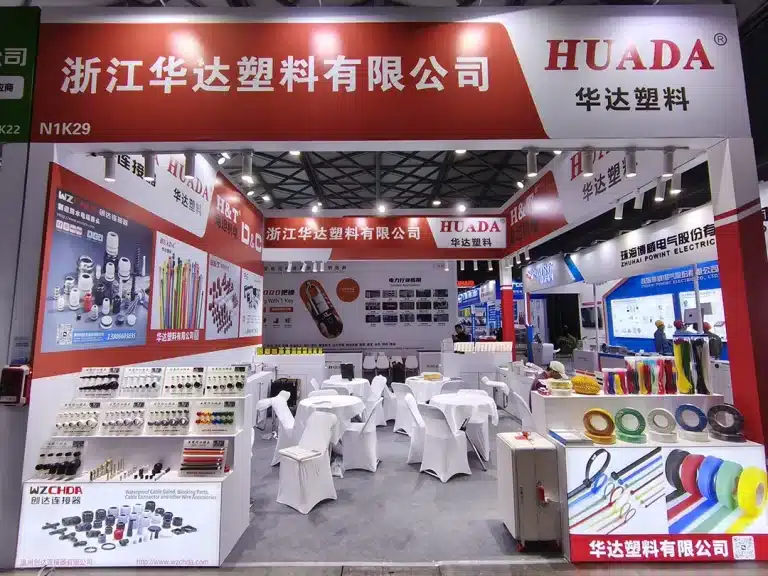As the year draws to a close, temperatures are steadily dropping across northern China, especially in Beijing, the capital city. In this cold environment, Cable Ties used outdoors face significant challenges, with daytime temperatures hovering around 0°C and nighttime often dipping below freezing.
In this article, we will showcase how cable ties perform in Beijing’s winter conditions through real-life examples. We will also discuss the impact of low temperatures on cable ties and share practical tips for choosing the right materials for different temperature ranges, ensuring stable and reliable use in cold weather.
Application of Cable Ties in Beijing’s Hutongs

From the images taken by my colleague Tom, we can see that in Beijing’s hutongs (traditional narrow alleyways), various outdoor cables are secured and managed using zip ties. While these applications may appear simple, the cold winter temperatures pose a challenge: can the ties remain stable, secure, and unbroken? Their performance directly impacts the organization of the cables and, in some cases, even safety.

As shown in the images, the cables are neatly bundled and firmly secured to the metal supports with cable ties, with no signs of loosening or sagging.

We can also observe a layer of frost covering both the cables and the cable ties, highlighting the harsh winter conditions. Even though Beijing’s average winter temperature hovers around 0°C or dips below freezing, these cable ties maintain their tensile strength and firmly hold the cables in place, despite the frost and cold.


Cable tie is quick and easy to install, requiring no tools. As demonstrated in the images, a simple pull tightens the tie, efficiently organizing the cables, with no additional effort or tools needed—excess length left untrimmed speaks to their ease of use.
These images illustrate three typical applications of cable ties in outdoor cable management:
- Cable Bundling: Multiple cables below junction boxes are neatly tied into bundles and secured to metal frames, reducing movement.
- Cable Routing Support: Cable ties are used at multiple points along the route to ensure the cables remain stable and neatly laid on the supports.
- Management of Indoor-Outdoor Connections: Even in complex outdoor environments, cable ties keep the cables tightly bundled and well-organized.
Although cable ties may seem unremarkable, maintaining reliable performance in low-temperature environments requires a higher level of quality. In northern winters, where temperatures drop significantly, the cold can impact the toughness and strength of materials. If cable ties become brittle or break, this could lead to loose cables or even pose safety risks for pedestrians.
So, how exactly does low temperature affect the performance of nylon cable ties?
The Impact of Low Temperatures on Cable Ties
The primary nylon cable tie materials are typically PA66 (Nylon 6,6) or PA6 (Nylon 6). These materials are known for their high mechanical strength and heat resistance. However, their performance can be affected under low-temperature conditions.
As discussed in our previous article, “Why Nylon Cable Ties Turn Brittle in Biting Cold,” cold weather can impact various properties of cable ties, including their strength, toughness, elastic modulus, crystallization behavior, and stress sensitivity. These changes make cable ties more prone to becoming brittle and breaking when exposed to freezing temperatures.
Choosing the Right Nylon Cable Tie Material for Low Temperatures
Some may wonder: “Does this mean nylon cable ties cannot be used in low-temperature environments?” The answer is no. With a professional cable tie manufacturer, high-quality materials, and suitable specifications, nylon ties can retain their strength and flexibility, even in freezing conditions, ensuring reliable performance.
Take Beijing as an example. While its winter temperatures are not as extreme as in northeastern China, the city’s unique combination of cold, dryness, and strong winds can still increase the risk of cable ties becoming brittle. For more insights, refer to our article, “Why Cable Ties Break in Winter and How to Solve It.”
To ensure cable ties perform reliably across various temperature ranges, and considering only the low-temperature resistance of different materials (without factoring in other conditions), we provide the following recommendations based on our previous low-temperature testing results:
- Around 0°C: Opt for cable ties made from Nylon 6, which offer stable performance and cost-effectiveness.
- From 0°C to -20°C: Nylon 66 cable ties are recommended for their superior cold resistance and toughness.
- Below -20°C: Use specially designed cold weather cable ties that maintain excellent strength and flexibility in extreme cold.
Please note that cable ties’ low-temperature performance may vary depending on the manufacturer and material formulations. At Nike Plastics, we take pride in providing nylon cable ties that have consistently performed reliably in winter conditions with no reported issues. Our recommendations are grounded in real-world applications, helping you make informed decisions for your specific needs.
With years of expertise in nylon cable ties, Nike Plastics provides high-quality standard products and customized solutions tailored to your requirements. For more information on cable tie selection and applications, feel free to contact us—we’re here to help with professional advice and reliable solutions.









